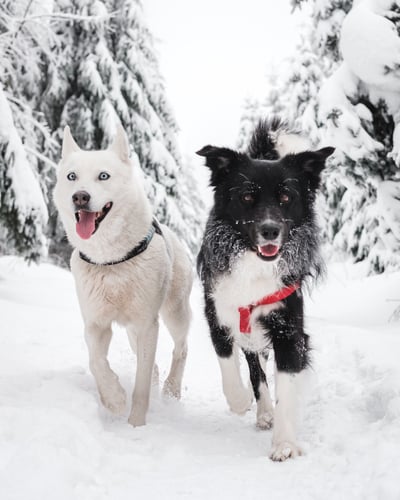Protecting Your Pet From Snow and Ice Treatments
Updated on: November 30, 2022 | Author: Starwood Pet Travel

For many of us, winter brings freezing temperatures and snow. The cold is no fun, but the snow is a source of major excitement for many pets as well as their humans. Well, dogs, anyway. Your cat may consider snow to be a personal affront. Whether your furry family member is a canine or feline, one thing they have in common is “boots” on the ground. You must protect those paws from salt and de-icer.
Safety begins at home
Snow and ice treatments typically contain chemicals that are toxic to pets (and, often, people). Salt is commonly used as a de-icer, and we tend to think of it as harmless because we use it in our food. In fact, putting salt on the ground can corrode surfaces such as asphalt and concrete, and it leaches heavy metals into our soil and water. If salt gets stuck in your pet’s paws, it can burn. And if pets ingest too much salt, it can make them sick.
Salt and other de-icing chemicals aren’t the only things that can make your pets sick during the winter. Vehicle antifreeze is something you would never deliberately spread on the ground outdoors, but tiny amounts of it could still be present in your driveway or garage. Antifreeze is deadly poisonous to pets.
At home, your goal is the safety of your family, two-legged as well as four. If you’re the owner or manager of commercial property, you are also concerned about potential liability issues should someone slip and fall. Either way, you can control what you use in the way of snow and ice treatments. Aside from salt, you can:
- Shovel or use a snow blower – if your space isn’t too large. You’ll still have a film of ice to contend with, though.
- Spread sand, which is non-toxic. It improves traction rather than melting snow, but it also can make a mess of pet paws in your house when your pets and you track the sand indoors. (In fact, the prospect of indoor hassle and damage is something to consider for any de-icing alternative.)
- Use calcium magnesium acetate or potassium acetate, which are non-corrosive and last longer than salt.
- Look for pet-friendly commercial alternatives.
- Try using a heated snow-melt pad, especially on your front porch.
Protecting your pet no matter where you are
Frosty as it may be outdoors, your dear dog still wants their daily walk or romp. So bundle up, because they need that exercise (and so do you) to stay fit and trim in the winter. But once they leave your own property, who knows what chemicals they will be stepping in? All these precautions will help protect them:
- Trim the fur on their paws so it does not extend past the pads. That will keep their paws cleaner and keep irritating ice balls from forming.
- Trim their nails, because shorter nails provide better traction.
- Don’t let them eat snow unless you know it’s clean. And don’t let them drink any puddled water.
- Don’t let him lick their paws.
- Try to talk your dog into wearing booties. Some pups take to rain or snow boots with little trouble, but for many, it takes “baby steps” for them to become comfortable with footwear. It is definitely worth the effort because boots protect paws from cuts and scrapes as well as cold and chemicals. (Plus, it's pretty funny to watch them try walking with booties.)
Prepare to clean those paws
This is inevitable if you hope to protect your pooch or kitty from snow and ice treatments, not to mention keep your house cleaner in winter. Since you should always rinse or at least wipe their paws when your pet comes into the house in winter, put a pile of clean towels by the door so you’ll be prepared.
Repeated exposure to cold and wet take a toll on your pet’s skin as well as yours. All the more so because, without booties, pets are bare-footed. Experts recommend using a paw balm to protect as well as soothe and moisturize paws. You can apply it before going out and again after you’ve cleaned your pet’s paws. There are several commercial products available, or you can make your own paw balm. Or you can try other recommended paw balms.
If you take sensible precautions and make every effort to use non-toxic snow and ice treatments yourself, your pet should have a safe and healthy winter.
Subscribe to the Blog
Enjoy our content? Get them sent to your inbox!
Subscribe Now!

